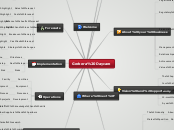Where next?
Where next?
If you have collected all the information you need for your business plan, and do not need the Smart Map wizard to guide you any more, you can convert your map to a regular Mindomo map and develop it for export to a word processor.
Good luck with your venture!
Welcome
Welcome
This Smart Map acts as a dashboard for developing a business plan. It helps you to organise your research and data, and answer the questions that an investor will ask.
This business plan is mainly designed to make the case for investment, although it could be adapted for other uses.
You will most likely need to return to it several times to add more information, especially where research is needed.
Gerbera Daycare
Type in your organisation name
Type in the name of your organisation and press Enter or click the right-arrow button to move to the next topic.
Marketing and sales
Marketing and Sales
The question that investors will ask is 'How will you turn your forecasts into reality?' Having identified your product or service, and the demand for it in the market, how will you reach that market?
As this is part of a business plan, it is not a fully developed marketing plan. You may need to develop this part of your plan in more detail for use as a marketing plan.
What you will sell
Describe what you will sell
Describe exactly what customers will buy, how they will buy it, how it will be provided or delivered, and how it will be supported after purchase. Think about:
- The selection and decision process
- Ordering and payment
- Delivery of real or virtual goods
- Access to real or virtual services
- Follow-up and post-sales services, including warranties
Campaigns
Campaign
Add a campaign
What campaigns are you planning to publicise your product or service? Examples include:
- Press releases
- Special offers
- Mailshots, physical or electronic
- A promotional series of advertisements
- A launch event or open day
- A competition or prize draw
Routes to market
Route to market
Add a route to market
List the ways that you can reach your market segments. Examples include:
- Retail locations, your own or others
- Direct sales representatives
- Distributors, resellers, catalogues and price lists
- Online presence
- Email, SMS and telephone calling
- Newsletters and leaflets
- Social media and word of mouth
- Shows and exhibitions
- Press coverage and reviews
- Advertising in newspapers, radio, television or specialist publications
- Roadside advertising, signs and notices
- Sponsorship
Market research
Describe your market research
What market research have you done to identify the best routes to market for your particular segment?
- Where is the best place for your target segment to find you?
- Where is the best place for you to find your target segment?
Operations
Operations
How will the operations of your organisation need to change, to support this plan?
In addition to understanding the opportunity and its potential, investors will need to know that you will also have the capabilities to deliver it, sustain it and scale it up.
Suppliers and partners
Supplier or partner
Add a supplier or partner
- What materials and services will you need from suppliers?
- Who will you need to partner with to make the most of the opportunity?
- Will you depend entirely on them, or do you have alternatives?
Staff, knowledge and skills
Staff and skills
Add staff, knowledge or skills
- What new staff will be needed?
- What skills and knowledge are needed?
- Will you be able to retrain existing staff?
- Can you recruit the right people?
- Are you expecting the investors to bring expertise and resources?
Development
Development projects
Add a development project
- What new things need to be designed and developed to deliver this opportunity?
- Are these new developments, or enhancements of existing products and services?
- Will they involve research and prototypes?
Processes
Process
Add a process
What new processes will you need to establish? Do you need to change existing processes? Processes include:
- Leadership and strategy
- Design and development
- Production & delivery
- Marketing and sales
- Financial and administrative
- IT and security
- Risk management
- Customer service and support
Equipment
Add capital equipment
What new equipment and tools will you need? Will you replace old ones, or extend your capacity?
Facilities
Facility
Add a facility
How will your facilities need to change to implement your plan? Will you need new premises or changes to existing premises?
Implementation
Implementation
If you win the investment or support that you need, where will you start?
Risks
Risk
Add a risk
How will you manage risk in your plan? What could go wrong? Think about delays, cost overruns, technical problems, legal problems, supplier problems, changes in the market, new competitors or even an unexpected increase in business that needs extra resources.
- How are you planning to reduce the chances of a problem occurring?
- How are you planning to reduce the impact if it does?
Next steps
Next step
Add a next step
- What are the next steps in your plan?
- If you win support, where will you begin?
- If you don't, what is your backup plan?
Milestones
Milestone
Add a milestone
What are the key points in the implementation of your plan? How will you know that you are making real progress? Think about:
- Signing key agreements and contracts
- Opening premises
- Appointing new staff
- Completing development and design work
- Prototypes and successful trials
- Events and campaigns
- First production
- First sales
- First press coverage and reviews
- Sales reaching breakeven level
- Profitability attained
Forecasts
Making forecasts
If you are proposing investment in your business, you will need credible forecasts of profitability and strategic benefits.
You will probably need to develop some of these forecasts in separate spreadsheets before summarising them here. You might also need to access financial expertise to prepare these forecasts.
Strategic challenges
Strategic highlights
Add a strategic point
What is the impact on your strategy of this initiative? How will your strategy change to ensure that you can adapt to whatever this plan brings, whether it is good or not so good? Think about:
- What assumptions you are making about the market and your capabilities
- How you will respond if these assumptions do not hold, e.g. if your main competitor changes direction, or if key staff leave
- The best and worst case scenarios
- How you will respond to best and worst case scenarios
- Your exit routes if things do not go according to plan
- How your strategic position will change
- What new opportunities could arise as a result of this change
Cashflow forecast
Cashflow highlight
Add a key point from the cashflow forecast
Even if your plan will eventually be profitable, cashflow limitations could prevent you from getting there. Your cashflow forecast should show that you are in control of this. Consider:
- The best and worst cases for financial exposure
- The effects of poor payment terms from suppliers
- The effects of late payment from customers
- When payback begins
- When payback completes and profitability begins
Breakeven analysis
Breakeven highlight
Add a key point from your breakeven analysis
Your breakeven analysis should show the minimum level of achievement that is still survivable. If operations go below breakeven, then you will need to take evasive action. Make forecasts for:
- Survival-level costs and expenses
- What could be delayed or dropped from the plan to reduce costs
- Worst cases for implementation delays and cost overruns
- Minimum sales performance
Profit and loss forecast
Profit and loss highlight
Add a highlight from your Profit and Loss forecast
Your profit and loss (or income) forecasts should detail where, when and how profitability will be achieved. Highlight changing revenues and changing costs over the time it will take to establish profitability. Consider making forecasts for year 1, year 2 and year 3 of your plan.
Balance sheet forecast
Balance sheet highlight
Add a key point from the balance sheet forecast
How will your balance sheet change as a result of this initiative?
- What new assets will you gain?
- What liabilities will you take on?
- How will the ownership of equity change?
- Will you have any intangible assets or contingent liabilities such as warranties?
Costs forecast
Cost highlight
Add a key point from the costs forecast
How will your costs base change as a result of your initiatives? Think about:
- Changes in fixed costs and overheads
- Changes in variable costs with volume
- Changes in variable costs with better equipment, better processes or better product design
- Changes in materials costs with volume
- Changes in marginal costs for virtual products
Sales forecast
Sales highlight
Add a key point from the sales forecast
How will sales increase as a result of your initiatives? Think about:
- Increased sales volume
- Increased average value of sales
- Increased sales to existing customers
- Opening up new markets and segments
Finance requirements
It must be clear to investors what you are asking for, when you need it, and when & how it will be repaid - in short, what value they will get for their investment.
Returns and repayments
Return or repayment
Describe how it will be repaid
Add highlights of the return or repayment plan for investors. Consider:
- Equity ownership and rising value of equity
- Equity buy-back
- Other benefits, e.g. future stock options
- Repayment of capital
Purpose
Investment purpose
What will you spend this on?
Summarise how this investment will be spent. Include:
- Purchasing assets
- Paying wages or overheads
- Buying stock and materials
- Investing in training or advisors
- Servicing loans
Schedule
Investment schedule
How much, and when?
Add a summary of how much is required, and when. If there are multiple stages then show each one separately.
The market
About your market
Investors will ask: how well do you know your customers and your market? Your business plan should show that you are targeting your market by well-defined segments, and are focused on creating value for customers.
Competitors
Competitor
Add a competitor
Add an organisation that can compete with you, either now or in the future. Think about all alternatives that the customer may have, including doing nothing, or addressing their problem in a completely different way.
Strategies
Strategy
Add a competitive strategy
How will you compete effectively? Add an element of your competitive strategy. Think about:
- Outperforming them on their strengths
- Outperforming them on their weaknesses
- Having a better value proposition
- Being different and difficult to compare
- Offering additional benefits
- Offering a better customer experience
Weaknesses
Add a weakness for this competitor
What do they do that is less attractive than your product or service? Do they have:
- Higher pricing?
- Lower performance or unreliability?
- A complex proposition that is difficult to understand?
- A poor reputation for value?
- Poor customer service?
- An inconvenient location?
Strengths
Strength
Add a strength for this competitor
What do they do that is more attractive than your product or service? Do they have:
- Better pricing or total cost of ownership?
- A more up-to-date design?
- Better performance and reliability?
- A good brand name and reputation?
- Good customer service?
- A more convenient location or means of access?
- Additional benefits?
Describe the competing product or service
- Do they compete with you now, or will they compete with you in the future?
- What do they provide that competes with you?
- Does it directly compete, or offer an alternative way to solve the problem?
Customers
Customer segment
Add a target customer group or segment
Who are your customers? Add a target customer segment. Groupings might include:
- ... by industry or trade
- ... by speciality or job role
- ... by region or locality
- ... by knowledge, concern, interest or need
- ... by demographic (e.g. age, gender, education, income)
Note that the same people may belong to more than one group, so may be reachable in several ways.
Solutions
Add a solution
What solutions are you offering for customers in this segment? What value do you create for them?
Needs
Add a customer need
What are the needs and interests of the customers in this segment? What do they value? How do they select their purchases?
Pain points
Add a customer pain point
What problems and pain points do the customers in this segment face?
Profile
Add a customer characteristic
What are the characteristic of the customers in this segment? How do you identify your potential customers?
Segment size
Size
Estimate the size of this segment
What is the estimated size and value of this segment?
What proportion of the segment is potential customers for you, taking into account competitors, market maturity and demand?
Market position
About your market position
Describe your market position
What market position are you aiming at? Think about:
- What segment you target
- How you compete
- Your 'brand values' - what you are known for
- Your visibility in the market
- How your competitors regard you
- How your positioning needs to change
The industry
About the industry
Describe your industry
Add some key points about the industry you are working in.
- What industry sector are you competing in?
- What are the characteristics of this sector?
- What kind of changes or trends are happening?
- What are the driving forces for change?
- Which parts are growing or shrinking?
Vision and opportunity
Vision and opportunity
We will begin with the part that is easiest to describe - your vision, and the opportunity that your plan is based on.
The investor's question we answer here is 'Where are you headed, and why?'
You might have an unshakable belief in your vision, but investors will be more sceptical, and will be looking for evidence of insight and a well-formed strategy.
5-year plan
Long term goal
Add a long-term goal
Where do you want to be in 5 years? Where would you like to be in terms of:
- Company size, turnover and profitability?
- Financial strength and independence?
- Structure and ownership?
- Market leadership and reputation?
- Competitiveness?
- Core skills and capabilities?
- Positioning for an exit strategy?
12-month plan
Short term goal
Add a short-term goal
Where do you want to be in 12 months? Where would you like to be in terms of:
- Turnover and profit or loss?
- Customer base and sales pipeline?
- Customer satisfaction levels?
- Market ownership?
- Staff, skills and technologies?
- Equipment and delivery capabilities?
- Consolidation and risk exposure?
Your USP
Describe your USP
Describe your USP
Add a key point about your Unique Selling Point. Your USP is what will lead marketing, and help customers to choose you over alternatives. In comparison to the alternatives, why will your product or service...
- ... be different?
- ... be desirable?
- ... be better value for customers?
- ... be better performing?
- ... be more accessible or convenient?
- ... offer a better experience?
- ... solve the customer's problems better?
- ... have easily understood benefits?
- ... fit in with the customer's typical behaviour, without needing them to change it?
Your strategy
Describe your strategy
Describe your strategy
Add a key point about your strategy. Strategy means having a bigger goal and an adaptable route map to navigate towards your goal. How does this opportunity...
- ... address your current weaknesses and challenges?
- ... exploit your capabilities and strengths, and build new ones?
- ... reduce future threats and competition?
- ... fit it with credible forecasts and trends?
- ... strengthen relationships and reputations?
- ... create value for your customers and investors?
The opportunity
Describe the opportunity
Describe the opportunity
Add a key point about the opportunity that you are pursuing.
- What do you plan to do? What product or service will you offer?
- Why does it need doing?
- Why is there a gap in the market?
- Has it been tried before? What happened?
- Why are you best placed to pursue it?
About your business
About your business
Investors will need a clear picture of your business: how it is structured, who owns it, who runs it, and how it is doing so far.
Values and principles
Value or principle
Describe your values & principles
Add some information about the values and principles at your company.
- Do you actively promote principles such as professionalism, respect, communication, leadership, accountability and trust?
- What is your policy on training and employee development?
- Do you have a policy on corporate citizenship?
- Do you deal with any ethical issues in your organisation? Do you observe any codes of conduct?
- Do you place emphasis on high quality, or on affordable cost?
- How important are innovation and risk in your market and company?
Achievements and track record
Achievement
Describe your track record
Add some information about your successes and achievements. Think about:
- Significant orders placed
- High profile customers you have won
- Innovative 'firsts'
- Case studies
- Awards, endorsements and recognition
- Accreditation, such as certification to ISO standards
- Patents and rights held
Relationships and partnerships
Relationship
Describe your company's partnerships
Add some information about important partnerships. Think about:
- Organisations you have partnered with
- The strategic advantages of relationships
- What dependencies you have on other partners
- Participation in industry associations
- Non-executive roles and investor seats on the board
- Independent professional advisors and coaches
Management team
Key team member
Describe your management team
Who are the key members of your management team, and what are their skills and experience?
Financial status
Your credit history
Summarise your credit position
Does your company have a good credit history? Can you negotiate favourable terms with suppliers?
Poor payment terms (such as cash with order) can affect cashflow while building up a new business.
Current business levels
Describe your current profitability
Add some information about your current profitability. For example:
- Turnover in last 12 months
- Profitability in last 12 months
- Order pipeline
Your investment
Describe your investment
Add some information about the current shareholding. How much have the current owners invested in the business?
Financial structure
Describe your financial structure
Add some information about the capital finance situation at your company.
- Who owns your company? Are you part owned by anyone else?
- Do you have shareholders?
- How would the shareholding change with financial support for this business plan?
- Do you have significant debts or financial obligations?
Regulatory environment
Regulatory condition
Describe the regulatory environment
Add some information about the regulatory environment that affects your company. Apart from company law, what other regulations apply to your sector? Consider:
- Industry regulation
- Bodies or associations with a code of conduct
- Consumer law & distance selling regulations
- Financial regulations and bonding requirements
- Privacy and data protection
- Insurance requirements
- Health & safety
- Professional training standards
- Operating licenses
- Equality and opportunity regulations
- Working with vulnerable groups
Legal status
Governance
Describe your governance
Add some information about the governance of your organisation.
- How are you governed and managed?
- Do you have a board of directors?
- Who is accountable to the owners?
- Who takes the key decisions?
Add your legal status
What is the legal status of your organisation? Are you a sole trader, a limited company with shareholders, or a non-profit?
Executive summary
Executive summary
Although the executive summary appears first in the document, it is easier to complete it last, when you can summarise and prioritise the key points in your plan.
Benefits
Summarise the benefits
List the benefits that will come from pursuing this opportunity. Include:
- Profitability
- Payback timescales
- Customer benefits
- Strategic benefits
Financial requirements
Requirements
Summarise your requirements
List the financial and other support that you are seeking, so that you can take advantage of this opportunity.
Opportunity
Summarise the opportunity
Briefly summarise the opportunity that your plan describes, and why it is strategic for your company.
Team and track record
Track record
Summarise your track record
Add the key points about the track record of your team and your capabilities.
Products & Services
Product or service
Summarise your products and services
Add short descriptions of the key products and services which bring your mission to life and are making it happen.
Mission statement
Your mission
Summarise your mission as an organisation
In one line, summarise the value and the difference that your organisation aims to create. Mission statements are more useful if they describe the difference that you want to make to your customer's lives, rather than what you want to achieve personally. Your mission statement should directly influence strategic decisions.
Generating profit and shareholder value are usually taken for granted for commercial organisations, so do not need to be in the mission statement.
Statement of confidentiality
Confidentiality statement
As your business plan is a commercially sensitive document, you may wish to add a confidentiality statement at the front of the document.









